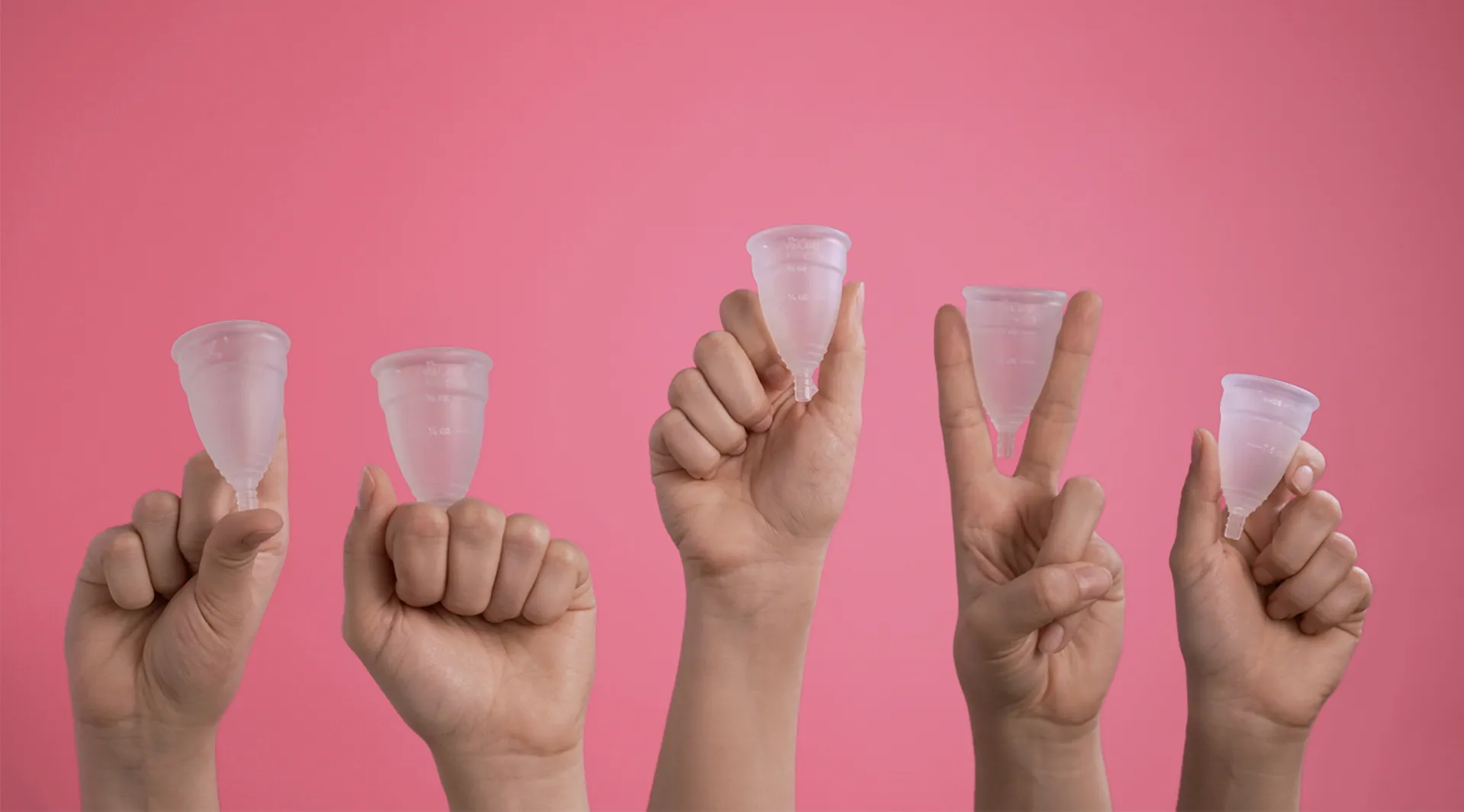Have you ever wondered how menstrual cups differ from tampons or pads? Well, you’re not alone! Menstrual cups are innovative and unique in their design and function. Unlike tampons, which absorb blood, menstrual cups collect it in a cup-shaped container that fits inside the vagina. This means that you don’t have to worry about the risks associated with toxic shock syndrome (TSS), a rare bacterial infection linked to tampon use.
Plus, menstrual cups have a higher capacity, allowing you to wear them for up to 12 hours without leakage. So, if you’re curious to learn more about the advantages and benefits of menstrual cups, keep reading!
Contents
What Is a Menstrual Cup?

A menstrual cup is a small, flexible cup-shaped device that is used to collect menstrual blood. It is a safer and more sustainable alternative to traditional menstrual products like tampons or pads. Unlike tampons, which absorb the blood, menstrual cups collect it in a cup-shaped container. This reduces the risk of toxic shock syndrome (TSS), a rare bacterial infection associated with tampon use.
Menstrual cups are made of medical-grade silicone, latex, or rubber, and they fit inside the vagina, held in place by the vaginal walls. Some cups have a small stem at the bottom for easy removal. Inserting and removing a menstrual cup can take some practice, but once you get the hang of it, it becomes a simple and efficient process.
One of the key advantages of menstrual cups is their capacity to hold more blood than tampons or pads. A menstrual cup can hold about one to two ounces of menstrual flow, while tampons can only hold up to a third of an ounce. This means that you can wear a cup for up to 12 hours, depending on your flow, without worrying about leakage or discomfort.
In addition to being safer and more efficient, menstrual cups are also eco-friendly. They are reusable and can last for years with proper care. This reduces waste and the use of resources associated with the production and disposal of traditional menstrual products. By switching to a menstrual cup, you can make a positive impact on the environment while also saving money in the long run.
Overall, menstrual cups offer a convenient, sustainable, and hygienic solution for managing your menstrual cycle. In the next sections, we will explore in detail how to insert and remove a menstrual cup, how to clean and care for it, and other important tips and considerations.
Why Use a Menstrual Cup?
Environmental Benefits
One of the main reasons to consider using a menstrual cup is its positive impact on the environment. Unlike disposable tampons and pads that end up in landfills, menstrual cups are reusable and produce much less waste. In fact, a single menstrual cup can last for years with proper care. Just imagine the amount of waste that can be avoided by making this switch!
By choosing a menstrual cup, you’ll be reducing your carbon footprint and contributing to a more sustainable future. It’s estimated that the average person who menstruates uses around 11,000 disposable menstrual products in their lifetime. That’s a staggering number, considering that most of these products take hundreds of years to decompose. Switching to a menstrual cup not only saves you money but also helps protect the environment.
Cost Savings
Speaking of saving money, using a menstrual cup can significantly reduce your monthly expenses. While the upfront cost of a menstrual cup may be higher than a pack of tampons or pads, you’ll end up saving hundreds of dollars in the long run. Think about it – no more monthly trips to the store to stock up on menstrual products. No more worrying about running out of supplies. With a menstrual cup, you make an investment once and reap the benefits for years to come.
Additionally, since menstrual cups can hold more blood than tampons or pads, you can go longer without needing to empty it. This means fewer trips to the bathroom and more time for you to focus on the things that matter. With a menstrual cup, you’ll experience convenience and cost savings that traditional menstrual products simply can’t offer.
Health Benefits
Apart from the environmental and financial advantages, using a menstrual cup also comes with several health benefits. Unlike tampons, which can absorb both menstrual blood and natural vaginal moisture, menstrual cups collect the blood without drying out your vagina. This helps maintain the natural pH balance and reduces the risk of infections and irritations.
Additionally, menstrual cups are typically made of medical-grade silicone, latex, or rubber, which are non-toxic and hypoallergenic materials. This means that you’re less likely to experience allergies or adverse reactions when using a menstrual cup. Plus, since menstrual cups don’t contain any chemicals or fragrances, they are a safer alternative for individuals with sensitive skin or allergies.
It’s important to note that using a menstrual cup does require proper hygiene and maintenance. Make sure to follow the manufacturer’s instructions for cleaning and sterilizing your cup between uses. With the right care, you can enjoy the numerous health benefits that come with using a menstrual cup.
As you can see, there are many compelling reasons to consider using a menstrual cup. From the environmental benefits to the cost savings and the health advantages, it’s a smart choice for both you and the planet. So why not give it a try and see how it can improve your menstrual experience?
How Does a Menstrual Cup Work?

A menstrual cup is a smart and innovative solution for managing your period. It’s a small, flexible cup-shaped device made of medical-grade silicone, latex, or rubber that is inserted into the vagina to collect menstrual blood. But how does it actually work? Let’s break it down for you:
- Insertion: To use a menstrual cup, you simply fold it and insert it into your vagina. The cup unfolds and creates a gentle seal against the vaginal walls, preventing any leaks or spills.
- Collection: As you go about your day, the cup collects the menstrual blood, thanks to its capacity to hold more fluid than traditional tampons or pads. This means you can wear it for up to 12 hours without needing to empty it, making it a convenient option for busy women on the go.
- Removal: When it’s time to empty the cup, you gently pull on the stem or base to break the seal and remove it. Empty the contents into the toilet, wash the cup with mild soap and water, and you’re ready to reinsert it.
- Reusable: Unlike disposable tampons and pads, menstrual cups are reusable and can be used for years with proper care. This not only saves you money in the long run but also reduces the amount of waste that ends up in landfills.
- Hygiene: It’s important to follow proper hygiene practices when using a menstrual cup. Wash your hands thoroughly before and after insertion and removal. Additionally, make sure to clean the cup with mild soap and water or a designated menstrual cup cleanser to maintain its cleanliness and prevent any potential infections.
By understanding how a menstrual cup works, you can make an informed decision about whether it’s the right menstrual product for you. With its ease of use, high capacity, and eco-friendly nature, a menstrual cup offers a convenient and sustainable solution to managing your menstrual cycle.
Choosing the Right Menstrual Cup
When it comes to choosing the right menstrual cup for you, there are a few factors to consider. Remember, every person’s body is unique, so what works for one person may not work for another. Here are some tips to help you find the perfect fit:
- Size: Menstrual cups come in different sizes, usually labeled as “small” and “large.” The size you choose depends on factors such as your age, whether or not you have given birth vaginally, and your flow. If you’re unsure, it’s best to start with a smaller size and then adjust as needed.
- Material: Menstrual cups are typically made of medical-grade silicone, latex, or rubber. Each material has its pros and cons. Silicone is soft and flexible, making it easy to insert and remove. Latex is more firm, providing a secure fit. Rubber cups are durable and long-lasting. Consider your preferences and any allergies or sensitivities you may have when selecting a material.
- Brand: There are numerous brands of menstrual cups available on the market. It’s essential to choose a reputable brand that meets safety and quality standards. Look for reviews and recommendations from other users to help guide your decision.
- Capacity: Consider your flow when selecting a menstrual cup. Cups come in different capacities, ranging from small to large. A higher capacity cup may be more suitable for heavy flow days, while a smaller cup may be sufficient for lighter days.
- Price: Menstrual cups typically range in price from $20 to $40. While it may be tempting to opt for a cheaper cup, keep in mind that quality and safety should be your top priorities. Investing in a higher-quality cup can ensure a comfortable and reliable experience.
Inserting and Removing a Menstrual Cup
Step-by-Step Guide to Insertion
- Wash your hands with soap and water before handling the menstrual cup.
- Fold the cup using one of the recommended folding techniques, such as the C-fold or punch-down fold.
- Find a comfortable position, whether it’s standing, squatting, or sitting on the toilet.
- Relax your pelvic muscles to make insertion easier.
- Hold the folded cup firmly between your thumb and forefinger.
- Gently separate the labia with your free hand to create a clear path to the vagina.
- Insert the cup into your vagina at a slight angle, aiming towards your tailbone.
- Push the cup in until the stem is just inside the vaginal opening.
- Use your finger to feel around the base of the cup to ensure it has fully opened and formed a seal.
- Rotate the cup slightly to ensure a proper fit and prevent any leaks.
Step-by-Step Guide to Removal
- Again, wash your hands with soap and water before removing the cup.
- Find a comfortable position, such as sitting on the toilet or squatting.
- Relax your pelvic muscles to make removal easier.
- Insert your index or middle finger into your vagina until you can reach the cup’s base.
- Gently squeeze the base of the cup to release the suction seal.
- Slowly pull the cup down and out of your vagina, keeping it upright to avoid spills.
- Empty the contents of the cup into the toilet or sink.
- Rinse the cup with water or wipe it with a mild, unscented soap.
- Reinsert the cup or store it in a breathable fabric pouch until your next use.
Remember, it may take a few tries to get the hang of inserting and removing a menstrual cup, especially if you’re new to using one. Be patient with yourself and give yourself time to practice and adjust to this new method of menstrual care.

- Comfort and Convenience: Many women find that menstrual cups offer a higher level of comfort and convenience compared to traditional menstrual products. The soft and flexible material of the cup makes it comfortable to wear, and its ability to hold more blood means fewer trips to the bathroom. With a menstrual cup, you can go about your daily activities without worrying about leaks or discomfort.
- Health Benefits: One of the main reasons women prefer menstrual cups is the health benefits they offer. Unlike tampons, which can absorb natural vaginal moisture and disrupt the pH balance, menstrual cups collect the blood without interfering with the body’s natural processes. This helps to prevent infections and irritations, making it a healthier option for managing your period.
- Cost Savings: Another factor that makes menstrual cups appealing to women is the cost savings they provide. While the upfront cost may be higher than traditional products, menstrual cups are reusable and can last for years with proper care. This means you won’t need to constantly purchase disposable products, saving you money in the long run.
- Environmental Consciousness: Menstrual cups are a sustainable choice that aligns with the growing concern for the environment. By using a menstrual cup, you can significantly reduce the amount of waste generated by disposable menstrual products. In fact, it’s estimated that a single menstrual cup can replace hundreds of tampons or pads over its lifespan.
- Freedom and Empowerment: Many women feel a sense of freedom and empowerment when using menstrual cups. The ability to wear the cup for up to 12 hours without worrying about leaks or changing products gives women more control over their menstrual cycle. It allows them to focus on their daily activities without interruption or discomfort, promoting a sense of empowerment and confidence.
These are just a few experiences shared by women who prefer menstrual cups. Each woman’s experience may vary, so it’s important to find the right cup that suits your individual needs. By considering factors such as size, material, brand, capacity, and price, you can make an informed decision and enjoy the benefits of using a menstrual cup.
Final Words
Menstrual cups are a safer, more sustainable, and cost-effective alternative to traditional menstrual products. Made of medical-grade materials, these cups offer numerous health benefits, including maintaining the natural pH balance and reducing the risk of infections and irritations. With their ability to hold more blood and provide up to 12 hours of wear without leakage, menstrual cups offer a higher level of comfort and convenience. Additionally, their eco-friendly nature helps reduce waste and aligns with the growing concern for the environment. By choosing a menstrual cup, you can experience a sense of freedom and empowerment, allowing you to focus on your daily activities without interruption or discomfort. So, if you’re looking for a healthier, more sustainable, and cost-effective option for managing your period, consider giving menstrual cups a try.
I am a medical student with experience and interest in Women’s health and well-being.